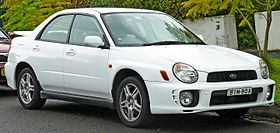This article needs additional citations for verification. (July 2018) |
| Subaru Impreza (second generation) | |
|---|---|
 | |
| Overview | |
| Manufacturer | Subaru (Fuji Heavy Industries) |
| Model code | GG |
| Also called | Subaru Outback Sport Saab 9-2X |
| Production | 2000–2007 (Japan) 2001–2007 (North America) |
| Model years | 2001–2007 2002–2007 (North America) |
| Assembly | Japan: Ōta, Gunma |
| Designer | Hidefumi Kato (1998)[1][2] Peter Stevens (2001) (2003 Facelift)[3] Andreas Zapatinas (2004) (2005 Facelift) |
| Body and chassis | |
| Class | Compact |
| Body style | 4-door sedan (GD) 5-door wagon (GG) |
| Layout | Front-engine, all-wheel drive |
| Powertrain | |
| Engine | 1.5 L EJ15 F4 1.5 L EL15 F4 1.6 L EJ16 F4 2.0 L EJ20 F4 2.0 L EJ20 F4 (t/c) 2.5 L EJ25 F4 2.5 L EJ25 F4 (t/c) |
| Transmission | 4-speed automatic 5-speed manual 6-speed manual (STI) |
| Dimensions | |
| Wheelbase | 2,525 mm (99.4 in) |
| Length | 4,415 mm (173.8 in) |
| Width | Sedan: 1,730 mm (68.1 in) Hatchback: 1,695 mm (66.7 in) |
| Height | 1,425 mm (56.1 in) |
| Curb weight | 1,360 kg (2,998.3 lb) |
| Chronology | |
| Predecessor | Subaru Impreza (first generation) |
| Successor | Subaru Impreza (third generation) Subaru Levorg (Station Wagon models) |
The second generation of the Subaru Impreza compact car was introduced in 2000 and manufactured up to 2007 by Subaru in Ōta, Gunma, Japan, in both sedan (GD series) and five-door Hatchback (GG series) bodystyles, as well as two intermediate facelifts throughout its lifespan.
The Impreza received naturally aspirated 1.5, 1.6, 2.0, or 2.5 liter flat-four engines, with the performance oriented WRX and WRX STI models upgraded to turbocharged versions of the two latter options. Export models typically received all-wheel drive, with front-wheel drive also available in the Japanese domestic market.
- ^ "USD449566S1 - Passenger car - Google Patents". patents.google.com. January 5, 2001. Archived from the original on March 23, 2020. Retrieved March 23, 2020.
- ^ "USD450013S1 - Passenger car - Google Patents". patents.google.com. January 5, 2001. Archived from the original on March 23, 2020. Retrieved March 23, 2020.
- ^ "Subaru Impreza - Peter Stevens Design". peterstevensdesign.co.uk. Archived from the original on August 6, 2013. Retrieved March 23, 2020.